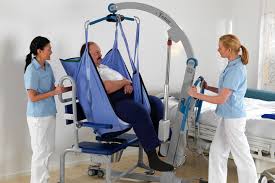Industry specific manual handling training is important because it takes into account the specific hazards and risks associated with manual handling in a particular industry. For example, manual handling training for warehouse workers will focus on the risks associated with lifting and moving heavy objects, while manual handling training for healthcare workers will focus on the risks associated with moving and handling of people. Companies MUST make their Risk Assessments and Training relevant to your site and the work that happens within it. Companies must also understand the hierarchy of control which details that manual handling should be a last resort.
What should industry specific manual handling training cover?
Industry specific manual handling training should cover a variety of topics, including:
- The risks of manual handling: Employees should be made aware of the risks of manual handling, including the risk of musculoskeletal disorders (MSDs), such as back pain, shoulder pain, and wrist pain.
- Understanding the methodology: Using Avoid, Assess, Reduce & Review as part of your Risk Assessment.
- The correct lifting techniques: Employees should be taught the correct lifting techniques for their particular industry, which may include using different lifting equipment or techniques depending on the specific hazards and risks involved.
- The use of aids and equipment: Employees should be shown how to use the correct aids and equipment for their particular industry, such as lifting belts, trolleys, and hoists. This can also include PPE & RPE.
- The importance of reporting injuries: Employees should be encouraged to report any injuries, no matter how minor, to their supervisor.
Why choose us for your manual handling training?
Our Manual Handling lead, Kim, is a former power lifter who has competed at various events and levels and has studied the art of lifting correctly. She is supported by experienced trainers who are drawn from industries such as care and emergency services. Prior to providing training, our trainers will assess the needs of the company prior and on the day of training to personalise the training to the individual company or site. We don’t just bring a box and ask you to pick it up from the table, turn around and place it on the floor, we’d rather go onto your shop floor and discuss practices that your staff currently carry out with the equipment they use. Find out more information about our manual handling training courses here.
The benefits of industry specific manual handling training
There are many benefits to providing industry specific manual handling training to employees. These benefits include:
- Reduced injuries: Industry specific manual handling training can help to reduce the number of injuries caused by manual handling.
- Increased productivity: Employees who are not injured are more likely to be productive.
- Reduced costs: The cost of injuries, such as medical expenses and lost productivity, can be high. Industry specific manual handling training can help to reduce these costs.
- A safer workplace: A workplace where employees are trained in industry specific manual handling is a safer workplace for everyone.
If you are looking for a way to improve safety in your workplace, consider providing industry specific manual handling training to your employees. It is a small investment that could save lives and money.  Here are some additional tips for preventing manual handling injuries:
Here are some additional tips for preventing manual handling injuries:
- Plan ahead: Before you lift or move a load, take a moment to plan the safest way to do it.
- Use the correct equipment: Use the correct equipment for the job, such as lifting belts, trolleys, and hoists.
- Get help if you need it: Don’t be afraid to ask for help if you are lifting or moving a heavy load.
- Take breaks: If you are lifting or moving loads for a long period of time, take breaks to rest your muscles.
- Listen to your body: If you are feeling pain, stop what you are doing and rest.
By following these tips, you can help to prevent manual handling injuries in your workplace.
We will be on hand to answer any questions, get in contact with us at [email protected], or use our contact forms on this website or via 0800 0096876.
You can also find some great information from the Health and Safety Executives website below.
For help with Risk Assessments, use the Manual Handling Assessments Charts (MAC TOOL).
Download a FREE copy of the HSE’s brief guide to manual handling.



 Here are some additional tips for preventing manual handling injuries:
Here are some additional tips for preventing manual handling injuries: